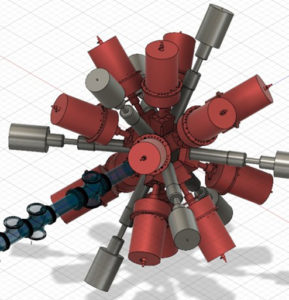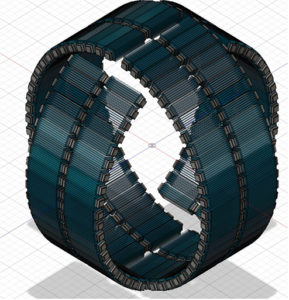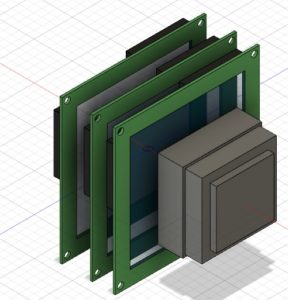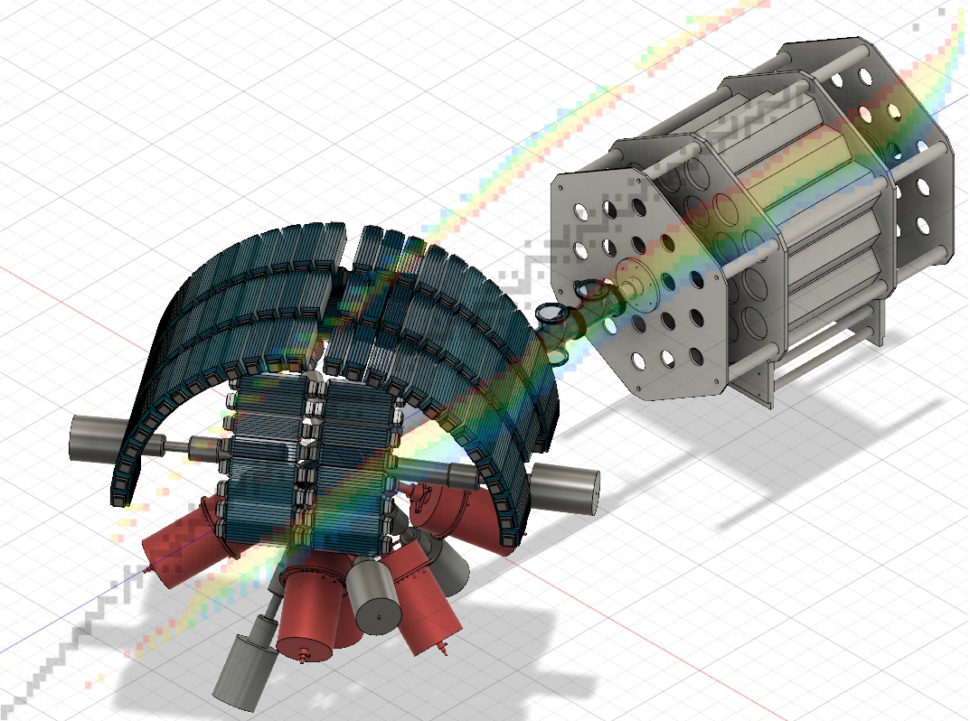What is the FRIB Decay Station?
The FRIB Decay Station (FDS) is an efficient, granular, and modular multi-detector system designed under a common infrastructure. The FDS will bring multiple complementary detection modes together in a framework capable of performing spectroscopy with multiple radiation types over a range of beam production rates spanning ten orders of magnitude. At the core of the FDS is a system to stop the incoming exotic ions and detect subsequent charged-particle decay emissions. Additional detector arrays will surround this system to measure emitted photons, neutrons, or both. The exact configuration of the charged-particle, photon, and neutron detection arrays will be dependent on the specific science goals of each experiment, and it will be adaptable to optimize tradeoffs between energy resolution, time resolution, efficiency, and background. Three new major devices have been proposed for the FDS: (1) a large-volume HPGe array, “DEGA”, (2) a neutron time-of-flight (TOF) array, “NEXT”, and (3) a silicon-scintillator hybrid implant detector, “XSiS”. The FDS will surpass previous generation systems through improvements to combined efficiencies (by factors of approximately 10 for βnγ and 50 for β2n2γ), granularity, background suppression, and resolution.
The FDS experimental program will focus on four strategic areas of FRIB: nuclear structure, nuclear astrophysics, tests of fundamental symmetries, and applications of isotopes for society. The FDS will be uniquely positioned for discovery experiments at the extremes of the accessible regions due to the high sensitivity and relatively low beam-rate requirements of decay spectroscopy techniques. In addition, for nuclei produced at higher rates, the FDS will be able to conduct high-precision measurements for thorough characterization of emergent phenomena, which can be used to benchmark and differentiate between leading models
DEGA (gammas)
New HPGe clover and small-anode detector array. Superb efficiency, superb energy resolution, and good granularity.

NEXT (neutrons)
New neutron time-of-flight array. Superb efficiency, superb granularity, and good energy resolution.

XSiS (charged particles)
New silicon-scintillator hybrid implant detector. Superb efficiency, superb granularity, and good energy resolution.

Recent News
- 2/2024 — Resolution from Atlanta workshop
- 2/2024 — New FDS UEC members elected
- 2/2024 — FDS and FDSi documents updated by community vote
- 11/2023 — FDS Collaboration Workshop in Atlanta
- 10/2023 — New Long Range Plan for NP highlights FDSi and FDS
- 9/2023 — Final 90% Review of FDSi Phase 2 designs completed
- 3/2023 — 5 FDSi proposals accepted by the second FRIB PAC
- 11/2022 — Fourth FRIB experiment uses the FDSi
- 11/2022 — FRIB PAC2 announced (due 1/23/2023), contact Kay Kolos to get involved
- 11/2022 — New FDS UEC members elected
- 11/2022 — First FRIB and FDSi Results Published
- 06/2022 — Second FRIB experiment uses the FDSi
- 05/2022 — First FRIB experiment uses the FDSi
- 08/2021 — 8 FDSi proposals accepted by the first FRIB PAC
- 08/2021 — First 90% Review completed for FDSi Phase 1
- 07/2021 — 60% Review completed for FDSi Phase 1
- 02/2021 — 12 FDSi proposals submitted to the first FRIB PAC
- 08/2020 — LECM and Day 1 Proposal Working Groups announced
- 06/2020 — FDSi Proposal Review (negotiations underway)
- 05/2020 — FDSi Proposal submitted to FRIB.
- 02/2020 — FDSi Coordination Committee formed.
- 08/2019 — FRIB Decay Station initiator (FDSi) Group formed.
- 08/2019 — FDS Users Executive Commitee formed.
- 08/2019 — LECM and FDS annoucements (check back soon)
- 01/2019 — The FDS White Paper has been submitted to FRIB Mgmt.
- 06/2018 — Workshop on γ-ray detection held at LLNL.
- 01/2018 — General workshop held at NSCL.
- 11/2017 — Workshop on γ-ray detection held at ANL.
- 01/2016 — General workshop held at JINPA-ORNL
